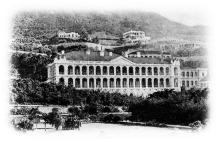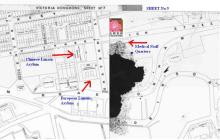This building - the European Lunatic Asylum - was built on Bonham Road in 1885 as a "proper Lunatic Asylum" for Europeans. It had 8 beds (4 for men and 4 for women).
It was not for treatment, but was a place where those with mental illness could stay pending return to their home country.
In 1895, this building and the nearby Chinese Lunatic Asylum merged into one and in terms of medical cover, the combined asylum was treated as an annex to the Government Civil Hospital.
The asylum era ended in 1925 when the term ‘lunatic asylum’ was substituted with 'mental hospital' – and the Chinese and European blocks became the Victoria Mental Hospital. The hospital had 23 beds.
In 1938 the mental hospital expanded again when part of the Medical Staff Quarters in High Street was converted for its use. These additional premises were used to treat women, increasing the total number of beds to 84.
In 1961, the Mental Hospital was moved to Castle Peak.



Comments
I'm a bit confused about what
I'm a bit confused about what belongs with what here. I think only the first two sentences are about this place, then there are two more different places described in the rest of the text. Is that right? Then the photo belongs with the last place?
There's a good view of this area in this photo from 1900.
This link might help clear
This link might help clear some things up
http://hongkongsfirst.blogspot.com/2009/10/hospitals-in-nineteenth-cent…
As a child I acted with the Hong Kong players who used the neighbouring building nicknamed "Spooky Hall" (built in the 20s or 30s I believe) as their rehearsal space from the 1960s until its demolition in the late 90s. I was fascinated by the building next door. Several of the players had gone next door (they had the key) and stripped the place. They said there wasn't much left and the floors were rotting through. The building was also filled with squatting junkies from the methodone clinic at the based of the hill (that building still stands).
Spooky Hall itself was in bad shape but I can remember climbing over a tall pile of furniture as a child to get into a bathroom filled with dead roaches. I stood on the toilet seat and looked into the inner courtyard / garden of the mental hospital. It was totally overgrown but had its own beauty. It was rumoured that the Japanese had executed people there during the war.
For years the "Ghost House" was considered to have such bad feng shui that no one dared build on it. I think when they finally did they have some series feng shui experts come in and sort the place out.
I really love that the developer kept the facade. If only more Hong Kong developers had used this approach.
Also the interior courtyard
Also the interior courtyard had a very beautiful upper walkway with ornate iron work.
Spooky Hall
Hi Chris, I think you're talking about this place. Any objections if I move your comments over there?
Regards, David
mental asylum
are these two separate places? bit confusing
3 different buildings
There were/are three different buildings. They each have their own special history, and at some point, were combined for one function, the Mental Hospital. I deleted the photo of the Staff Quarters so as not to confuse people.
So what is the best way to show this in Gwulo. I've created 3 separate "places".
re: 3 different buildings
Thanks for the map, that makes it clear.
For the initial introduction above, I think it helps to make it obvious when you're talking about this building, and when you're talking about nearby buildings, eg:
This building was built on Bonham Road in 1885 as a "proper Lunatic Asylum" for Europeans. It had 8 beds (4 for men and 4 for women).
It was not for treatment, but was a place where those with mental illness could stay pending return to your home country.
In 1895, this building and the nearby Chinese Lunatic Asylum merged into one and in terms of medical cover, the combined asylum was treated as an annex to the Government Civil Hospital.
The asylum era ended in 1928 when the term ‘lunatic asylum’ was substituted with 'mental hospital' – the Victoria Mental Hospital. The hospital had 23 beds.
In 1938 the mental hospital expanded again when part of the staff quarters in High Street was converted for its use. These additional premises were used to treat women, increasing the total number of beds to 84.
Details of your sources will also be a big help to any reader that wants to clarify / confirm these details.
Regards, David
Was this the only asylum?
I am just wondering if this was the only asylum available? My great grandfather died in an asylum - my mother told me she remembered being taken to say goodbye to him and that he was in a straitjacket. (Strange thing to do to a child!) As far as I understand it, he would not have been 'treatable', he would have been incarcerated in the expectation of his death (1919). I'd be interested to find out where he is likely to have been sent. The family was Macanese in origin, so I have no idea whether this would have a bearing on his likely institution. Many thanks.
re: Was this the only asylum?
I believe this was the only government-run asylum in Hong Kong in 1919. Page Z5 of the Blue Book for 1919 says 8 of the asylum's patients died that year, 6 male and 2 female.
Several of the religious organisations in Hong Kong at that time ran orphanages and hospitals. I don't know if they also cared for people with mental health problems.
Thank you! That could well…
Thank you! That could well have included my ancestor.